
http://www.iaeme.com/IJMET/index.asp 80 editor@iaeme.com
International Journal of Mechanical Engineering and Technology (IJMET)
Volume 10, Issue 03, March 2019, pp. 80-88. Article ID: IJMET_10_03_008
Available online at http://www.iaeme.com/ijmet/issues.asp?JType=IJMET&VType=10&IType=3
ISSN Print: 0976-6340 and ISSN Online: 0976-6359
© IAEME Publication Scopus Indexed
INDUSTRIAL CONFLICT AND COLLECTIVE
BARGAINING: EVIDENCE FROM NORTH
CENTRAL REGION OF NIGERIA
ASAMU Festus Femi
Department of Sociology, Landmark University, Oma-Aran, Nigeria
Abiola John Asaleye
Department of Economics, Landmark University, Omu Aran, Nigeria
Ogadimma Arisukwu
Department of Sociology, Landmark University, Omu Aran, Nigeria
Bamidele Rasak
Department of Sociology, Landmark University, Omu Aran, Nigeria
ABSTRACT
Industrial conflicts in organizations are inevitable due to disagreement between the
employees and employers which can either benefit or harm the organization. For the efficacy
of the employer, there should be very positive ties between employer and workers. This study
therefore, focuses on the use of collective bargaining as an effective instrument for
management of conflict in Store Product Research Institute, in the north central of Nigeria.
The study made used of pluralist theory as frameworks and employs both qualitative and
quantitative research techniques. The findings of the study shows that negotiating via the
process of collective bargaining on the terms and conditions of employments were not
satisfied to the employees in the way the management of the institution handle them.
Therefore, a proactive collective bargaining procedural and substance rules are
recommended for both parties to reach collective agreement.
Key words: Industrial conflict, employer and worker relationship, Labour
Cite this Article: Asamu Festus Femi, Abiola John Asaleye, Ogadimma Arisukwu
and Bamidele Rasak, Industrial Conflict and Collective Bargaining: Evidence from
North Central Region of Nigeria, International Journal of Mechanical Engineering and
Technology, 10(3), 2019, pp. 80-88.
http://www.iaeme.com/IJMET/issues.asp?JType=IJMET&VType=10&IType=3
1. INTRODUCTION
The workplace is composed of different values, beliefs and attitudinal behaviour of both employers
and employees. The employee is the engine room of any organisation and plays a strategic position in

Asamu Festus Femi, Abiola John Asaleye, Ogadimma Arisukwu and Bamidele Rasak
http://www.iaeme.com/IJMET/index.asp 81 editor@iaeme.com
production process and profit making. However, in order for workers to perform effectively and
efficiently there must be a strong union between workers and the organisation managers (Chen, Chen
& Chen, 2018). It should be noticed that irrespective of the relationship of social elements in work
organisations, conflicts are inevitable because there are inherent competing interest either in wages or
terms and condition of service workers (Tom & Shepherd, 2017). In Nigeria industrial sectors today,
conflicts and union disputes has consumed a lot of time and human hours waste. This situation
hampered the growth and processes of many organisations in Nigeria (Ojielo, 2002). Likewise, in
Nigeria studies have stressed that low income and high unemployment rate remained macroeconomic
problems despite various attempts by the policy makers (Asaleye, Isoha, Asamu, Inegbedion,
Arisukwu & Popoola, 2018; Asaleye, Adama & Ogunjobi, 2018). Therefore, effective management of
industrial conflict can help not to worsen the unemployment situation in Nigeria.
Most conflict between management and their workers often start as mere grievances; and when it
cannot be handled, it result into strike action, slow work, workplace sabotage, high labour turnover,
low morale, absenteeism, loss of human energy, decreased job satisfaction, low productivity and host
other effects that are detrimental to work organisations. With increase in diversity, conflict in the
workplace cannot be ruled out, even with the presence of labour union. Conflict between ownership of
the organisations and the workers is known as industrial conflict. Industrial conflict is the discord that
occurs when the goals and values of different individuals or groups are incompatible and antagonistic
to each other (Asamu, 2015). However, when industrial conflicts occur constantly, it sires room for
strike. Strike eventually forces employers to concede to employees demand. Most times, strike actions
are used to change the structure of bargaining and to win substantive demand by workers. Collective
bargaining is therefore seen as a process of meeting, presenting demands, discussing, presenting
counter proposals and sometimes bullying and threatening, all a bid to reach an agreement.
Theoretically, there is no model that fully explains how collective bargaining should be used in the
presence of conflict; this is due to the complexity involved (McCarter et al, 2018; Lv, Li & Tang,
2017). By nature, collective bargaining is usually a complicated time- consuming and exasperating
exercise. The ultimate goal of any negotiation is the agreement which may not necessary resolve all
the issues in dispute. However, deliberate refused to honour collective agreement arrived through the
consensual process of collective bargaining are rife among employers and management representative
of some public organisation when processes like these are jettisoned, resulted into information gaps
and worsen the situation (Feicht, Grimm, Rau & Stephan, 2017).
In view of the above, the relationship between employees and their employers is not deprived of
conflict. However, collective bargaining is the tools used to resolve amicably contending labour issues
between employees and employer. The current democratic regimes in Nigeria have witnessed series of
industrial conflicts than ever before because of their inability to pay employees as at when due. In this
vein, this study investigates the relationship between industrial conflict and collective bargaining
process in store product research institute in Nigeria.
2. LITERATURE REVIEW
On conceptualizing industrial conflict and collective Bargaining, union and management interest are
different from each other as a result of this, they continue to have conflict in the work place. Industrial
conflict is view as the disagreement of interest which results into discontentment of different degree
between employers and employees in the workplace. Chen et al (2018) opined industrial conflict as the
failure of employers and employees to reach agreement which may eventually lead to industrial
strikes, lockout or other forms of protestation. Industrial conflict does not necessarily directly affect
the actors in an industry but rather it often makes the actors to impose sanctions so as to inflict
economic pain on each, in order to achieve their demand. In case of the workers there are various
economic sanctions that will bring employers down in other for them to achieve their objective. These
economic sanctions include, picketing, rag wearing, overtime ban, strike, blacklisting, work-to-rule
etc. but „strike‟ remains the most visible weapon used by workers. Alternatively, the employers
making use of „lock-out, dismissal, suspension, no-work no-pay among others to inflict pain on the
workers during trade dispute (Imiafidoh, 2006). According to this perspective, industrial conflict is not
necessarily dysfunctional but rather depends on how it can be managed by the parties concerned.
Collective bargaining is also defined as negotiations about working conditions and terms of

Industrial Conflict and Collective Bargaining: Evidence from North Central Region of Nigeria
http://www.iaeme.com/IJMET/index.asp 82 editor@iaeme.com
employment between an employers, a group of employers or one or more employer‟s organisations
and one or more representative of workers‟ organisation with a view to reaching agreement (Liu, Lv,
Li & Tang, 2017).
Theoretically, different models have been advanced to show the relationship between collective
bargaining and conflict in an organisation. McCarter et al (2018) review five models of intragroup
conflict in management studies. The scholars concluded that despite the fact that the models have
made significant effects in contributions on how to manage conflicts in the society, there is still a need
to develop another model due the complexity of the human behaviour. In a similar study, Liu, Lv, Li
and Tang (2017) examined the role of bargaining model of labour in relation to disputes and social
mediation bounded rationality. It was documented by the scholars that final result of labour dispute did
not only associated on the different model advanced. However, there are certain features that need to
be put into considerations, among include the „path dependence‟. It was concluded by the scholars that
a solution that benefit the society can be reached by taking advantage of social mediation.
The Pluralist theory shows the relationship and roles between employment and industrial relation
(Budd, Gomez & Meltz, 2004; Commons, 1957; Flanders, 1965). According to this theory,
employment relationship is regarded as a bargaining problem which depends on the distribution of
resources as well as the rules governing the interactions between employers and the employees. Due to
this effect, the introduction of labour union, public policies and relevant institutions can help to
eliminate or reduce conflict in the society. Central to this argument is the role of collective bargaining
in industrial conflict. Empirically, Chen, Chen and Chen (2018) investigated the role of collective
bargaining against unionized workers in the strategic choice of method payment in corporate
acquisitions. The findings of the scholars showed that there is a significant positive relationship
between union power and cash payment. Also, the association of the relationship is strengthen more
when the firm is located in states without the right-to-work law. Consequently, the study by Feicht,
Grimm, Rau and Stephan (2017) examined the impact of quotas and decision rules in collective
bargaining. The authors reported that negotiations do not have significant effect if the environment
gives insufficient guidance on what to be achieved. Likewise, Tom and Shepherd (2017) analysed the
relationship between accounting and social conflict in profit and regulated working time in the British
Industrial Revolution. Their findings show that the cost behaviour in most time is used to increase or
decrease the apparent effects of reduced working time on profit.
The general picture from the conceptual, theoretical and empirical perspectives is that each party
either employer or employee aimed at maximising benefits which results to conflict. Though, elements
of complexity are involved due to complexity, the collective bargaining is one of the methods
identified to improve the situation. In recent times in Nigeria, different organisation conflicts had
emerged with resulted to retrenchment of employment. High unemployment, poverty rate and low
income rate are some of the macroeconomic issues in the country (Fashina, Asaleye, Ogunjobi &
Lawal, 2018; Oloni, Asaleye, Abiodun & Adeyemi, 2017). Likewise, most studies in Nigeria have
focused on the banking industries and state government workers. This study, however, investigates the
relationship between industrial conflict and collective bargaining process in store product research
institute in Nigeria.
3. THEORETICAL FRAMEWORK AND METHODOLOGY
3.1. Theoretical Framework
Pluralist theory is adopted as theoretical framework for this study. This perspective attempts to apply
the analogy of pluralism in society where there are diverse socio-cultural group, which compete for
scarce resource, for instance power. This diversity could be in terms of ethnicity, religious affiliation,
social class, political orientation among others. If in the society these diverse aspects are allowed to
interfere in our everyday life, they are going to bring about: sectionalism, squabbling and conflict
which could even tear society apart. In the same way work place is made of individual and groups who
are also divers. To harmonize these diversities and pluralism, there must be some mechanism at work
which will bring the competing groups together and hold them back from tearing the work place into
pieces. This mechanism should be a continuous process of concession and compromise. Collective

Asamu Festus Femi, Abiola John Asaleye, Ogadimma Arisukwu and Bamidele Rasak
http://www.iaeme.com/IJMET/index.asp 83 editor@iaeme.com
bargaining is seen as the mechanism for achieving this while the employer and trade unionism
represent these interests for those in the work place that engage in collective bargaining (Budd, Gomez
& Meltz, 2004; Commons, 1957; Dunlop, 1958; Flanders, 1965).
This perspective also argues that the legitimacy and justification of trade union in the relationship
rest upon their success, real or supposed. To be recognize, to engage in collective bargaining, to
achieve the objectives of their work place is a reflection of diverse interest group in the work place, as
well as power relations between these interested groups. The theory is relevant in the sense that
organizations have different ideology; goals that they want to achieve As a result, labour union
becomes the legitimate representatives of employees in the workplace. Thus, the system of industrial
relation gets grounded on the product of discontentment and compromises between management and
labour union. Pluralist theory to industrial conflict is contend that just as the society seen as a coalition
of various interest groups held together in balance by the state agency, so is industrial and work
organisation are seen as being held balance, by the management agency. Labour unions are seen as
legitimate representatives of workers‟ interest at workplace with the right to challenge management
prerogative. The perspective considers as the central features of industrial relation; the potential
conflict which exist between management and the managed within the work enterprise.
However, labour union is seen as both representing the interest of the employees and as well
playing important role in regulating this conflict. Similarly, collective bargaining is recognised as
being the organisational avenue by which conflict in industry is controlled and regularized. The theory
therefore considers industrial conflict as being not only inevitable but more important requiring
containment within the socio-mechanism of collective bargaining. This theory will be appropriate for
this study in analysing the industrial conflict and collective bargaining process in Nigeria Store
Product Research Institute because the theory is easy to visualised industrial relation as a process of
balancing power among overlapping economics, social, ethnic and geographical groupings.
4. METHODOLOGY
The survey research design was used to collect data from sampled population through the adoption of
questionnaire and interview methods. The study population is 1,203 staff which consists of the
management and academic and non-academic staff unions in Nigeria Store Product Research Institute
under the federal Ministry of Agriculture and Rural Development, Ilorin, Kwara state. The Nigerian
Stored Products Research Institutes (NSPRI) was established in 1954 to conduct research in all aspects
of harvest handling of agricultural crops and their products, pesticide development, residue analysis
and mycotoxin surveys on food items in Nigeria as stated in Decree 5 of 1977. The research method
use forty per cent of the total population as sample size summing up to 480 staff selected through
stratified sampling. Questionnaires were administered on 480 staff. The administration of research
instruments took cognizance of the strata namely management and junior staff, Academics and non-
academic staff unions which spread across all departments.
5. RESULTS AND DISCUSSION
5.1. Presentation of Results
5.1.1. Personal Information of the Respondent
This section represents the personal information of management and workers in Nigeria store product
Research Institute, Ilorin, Kwara State, Nigeria.
5.1.2. Personal Data of Respondents
Table 1: Distribution of Respondents According to their Socio Economic Characteristics
Variable
Frequency
Percentage
Age
20 – 30 years
48
10.0
31 – 40 years
208
43.3

Industrial Conflict and Collective Bargaining: Evidence from North Central Region of Nigeria
http://www.iaeme.com/IJMET/index.asp 84 editor@iaeme.com
41 – 50 years
156
32.5
50 years and above
68
14.2
Total
480
100
Sex
Male
352
73.3
Female
128
26.7
Total
480
100
Marital Status
Single
116
24.2
Married
348
72.5
Widow/Widower
12
2.5
Divorce
4
0.8
Total
480
100
Year of Employment
Less than 1 year
52
10.8
1 – 5 years
152
31.7
6 – 10 years
88
18.3
Over 10 years
188
39.2
Total
480
100
Educational Qualification
WAEC
36
7.5
BSc. /HND
404
84.2
Others
40
8.3
Total
480
100
Source: Author‟s Field Survey, 2017
Table 1 reveals that 48 about 10.0 per cent of the 480 respondents used in this study are within the
age group 20-30. Similarly, 208 about 43.3 per cent are within the age group 31-40, Then 156
approximately 32.5 per cent are within the age group of 41-50, while 68 per cent around 14.2 per cent
are above 50 years of age. This shows that majority of respondents used for this study are within age
bracket of 31-40. It can be deduced that the active labour force are in the organization, this set of age
are active in union participation. Meanwhile, 73.3 percent of the respondents are males while 26.7 per
cent are females from the distribution, it can be infer that male dominated the organization making
their opinion viewed compared to the female respondents. Also, table 1 indicated that 75.5 per cent of
the respondents are married, 24.2 percent the total respondents are single. In addition, years of
employment was measured 10.8 percent of the respondents have employed for less than a year. 31.7
per cent were employed for period of 1-5 years, 18.3 percent of the respondents were employed
between 6-10 years. While those employed for over 10 years above measured 39.2 percent. On
educational qualification, the respondents with WAEC and equivalent 7.5 per cent of the total
respondents, 84.2 percent of the respondents claimed they BSc and HND, while 8.3 have others like
college of education certificate and primary school leaving certificate.
5.1.3. Industrial Conflict and collection bargaining process
This sub-section deals with causes of industrial conflict, issues of negotiation for collection bargaining
and machinery uses for effective collective bargaining process.
Table 2 Causes of Industrial conflict in Nigeria Store Product Research Institute
Variable
Frequency
Percentage
Workers satisfaction
Satisfied
184
38.3
Not satisfied
296
61
Free Hand of union
Yes
372
77.5
No
84
17.5
Undecided
24
5.0
Root of Conflicts


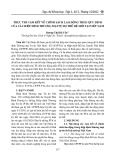
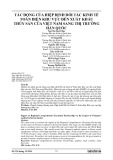
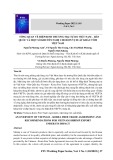
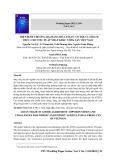
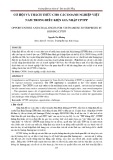
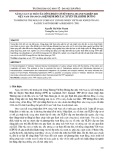



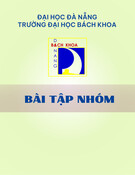






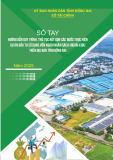
![20 câu hỏi Quản lý dự án phần mềm có đáp án [mới nhất]](https://cdn.tailieu.vn/images/document/thumbnail/2025/20251003/hieu2004haha@gmail.com/135x160/78791759734259.jpg)


![Tài liệu Quản lý dự án: Kiến thức nền tảng toàn diện [chuẩn SEO]](https://cdn.tailieu.vn/images/document/thumbnail/2025/20250910/kimphuong1001/135x160/92631757496585.jpg)



